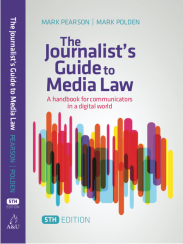By MARK PEARSON Follow @Journlaw
We have removed the comparative reporting restrictions tables from the fifth edition of The Journalist’s Guide to Media Law (Allen & Unwin, 2014) which will be published later this year.

Order through Booktopia at http://www.booktopia.com.au/the-journalist-s-guide-to-media-law-mark-pearson/prod9781743316382.html
Co-author Mark Polden and I have decided to move these comparative tables on reporting restrictions throughout Australia across to this blog – journlaw.com – so we could free up space in the new edition to discuss other important issues such as media law for public relations consultants and the implications of digital and social media.
We will work to update the reporting and publishing restrictions tables over coming months, but for the moment I am publishing them as they stood at the date of our fourth edition in 2011.
As I upload them over coming weeks I would appreciate any students or colleagues using the comments section below to advise of any updates in your jurisdictions and I will act to update the tables accordingly.
Looking forward to your collaborative input!
——
Restrictions on reports of proceedings involving children
Note: NO identification of parties or witnesses in any way under the Commonwealth Family Law Act s. 121.
| Jurisdiction | Law | Exceptions | Legislation |
| ACT | Reports of proceedings: Media allowed to report. ID: Cannot be identified. Cannot publish account of family group conference— | None mentioned. | Criminal Code 2002, s. 712A. Children and Young People Act 2008, s. 77. |
| NSW | Reports of proceedings: Media allowed to stay and report. ID: No ID of child mentioned or otherwise involved (including victims and witnesses) living or dead, during or after proceedings, or their siblings.— | Court may close proceedings. Court may allow ID or children aged 16 or over can authorise.(Seek legal advice on this.) Or senior next of kin or court (if deceased).
|
Children (Criminal Proceedings)Act 1987, s. 15A; Children and Young Persons (Care and Protection) Act 1998, ss. 104 and 105; Young Offenders Act 1997, s. 65. |
| NT | Reports of proceedings: Open court and reports allowed. ID: No restriction.— | Magistrate may close court or order suppression. | Youth Justice Act 2005, ss. 49, 50. |
| Qld | Reports of proceedings: No. ID: No ID of child accused without court’s permission. No ID of child witness in sexual matter. ID of child witness okay in other matters unless ordered otherwise. Cannot ID authorised officer or police officer in matters with child witnesses. No ID info about child victims. No ID of children subject to allegations of harm or risk of harm or in state custody or guardianship.— | Judge may order publication of identifying information for heinous crimes. Court can permit reporting when otherwise prohibited.Child victim can consent after becoming adult if fully informed of publication matter, audience and reason. | Youth Justice Act 1992, ss. 234, 301. Child Protection Act 1999, ss. 189, 192, 193. |
| SA | Reports of proceedings: Court open to ‘genuine representatives of news media’. No family care proceedings reports. ID: No ID of child parties, witnesses or victims,or other persons other than in official capacity without their permission, including name, address or school. Documentaries may be approved under strict conditions.— | Courts can authorise some reports and ID. | Youth Court Act 1993, s. 24; Young Offenders Children’s Protection Act 1993, s. 59, Children’s Protection Act 1993, s. 13; 59A. |
| Jurisdiction | Law | Exceptions | Legislation |
| Tas. | Reports of proceedings: No provision for media to be present without permission of court. ID: No ID of youths or youth witnesses.— | Permission of court. | Youth Justice Act 1997, ss. 30, 31; Magistrates Court (Children’s Division) Act 1998, ss. 11, 12. |
| Vic. | Reports of proceedings: Open court and media allowed to report. ID: No identification of child accused or any witnesses to case. No mention of court venue. Long list of banned ID particulars for children and witnesses including: name, title, pseudonym, alias of the person, home or work address or localit0, school or locality; physical description or style of dress; occupation or calling; relationship to identified others; interests or beliefs; real or personal property. No photos.— | Permission of court. | Children, Youth and Families Act 2005, ss. 523, 534. |
| WA | Reports of proceedings: Yes ID: No ID on child involved in proceedings in any way. No ID of child subject of a protection application or order.— | Court can exclude persons. Supreme Court can authorise ID of child. | Children’s Court of Western Australia Act 1988, ss. 31, 35, 36, 36A. Children and Community Services Act 2004, s. 234 |
—————
Disclaimer: While I write about media law and ethics, nothing here should be construed as legal advice. I am an academic, not a lawyer. My only advice is that you consult a lawyer before taking any legal risks.
© Mark Pearson 2014







Pingback: Naming and shaming’ juvenile offenders or open justice? A new battle over press freedom - Times of News
Pingback: 'Naming and shaming' juvenile offenders or open justice? A new battle over press freedom
Pingback: My latest Conversation piece on media implications of NT youth justice proposals #MLGriff | journlaw